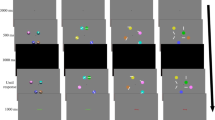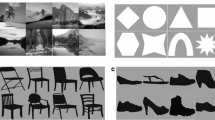Abstract
Representations in visual short-term memory are considered to contain relatively elaborated information on object structure. Conversely, representations in earlier stages of the visual hierarchy are thought to be dominated by a sensory-based, feed-forward buildup of information. In four experiments, we compared the spatial resolution of different object properties between two points in time along the processing hierarchy in visual short-term memory. Subjects were asked either to estimate the distance between objects or to estimate the size of one of the objects' features under two experimental conditions, of either a short or a long delay period between the presentation of the target stimulus and the probe. When different objects were referred to, similar spatial resolution was found for the two delay periods, suggesting that initial processing stages are sensitive to object-based properties. Conversely, superior resolution was found for the short, as compared with the long, delay when features were referred to. These findings suggest that initial representations in visual memory are hybrid in that they allow fine-grained resolution for object features alongside normal visual sensitivity to the segregation between objects. The findings are also discussed in reference to the distinction made in earlier studies between visual short-term memory and iconic memory.






Similar content being viewed by others
References
Averbach, E., & Coriell, E. (1961). Short-term memory in vision. Bell System Technical Journal, 40, 309–328.
Awh, E., Barton, B., & Vogel, E. K. (2007). Visual working memory represents a fixed number of items regardless of complexity. Psychological Science, 18, 622–628.
Bar, M., Kassam, K. S., Ghuman, A. S., Boshyan, J., Schmid, A. M., Dale, A. M., ... Halgren, E. (2006). Top-down facilitation of visual recognition. Proceedings of the National Academy of Sciences of the United States of America, 103, 449–454.
Becker, W. M., Pashler, H., & Anstis, S. (2000). The role of iconic memory in change-detection tasks. Perception, 29, 273–286.
Ben-Shalom, A., & Ganel, T. (2012). Object representations in visual memory: Evidence from visual illusions. Journal of Vision, 12, 1–11.
Biederman, I. (1985). Human image understanding: Recent experiments and a theory. Computer Vision, Graphics, and Image Processing, 32, 29–73.
Block, N. (2007). Consciousness, accessibility, and the mesh between psychology and neuroscience. Behavioral and Brain Sciences, 30, 481–548.
Block, N. (2011). Perceptual consciousness overflows cognitive access. Trends in Cognitive Science, 15, 567–575.
Brady, T. F., Konkle, T., Alvarez, G. A., & Olivia, A. (2013). Real-world object are not represented as bound units: Independent forgetting of different object details from visual memory. Journal of Experimental Psychology: General, 142, 791–808.
Coltheart, M. (1980). Iconic memory and visible persistence. Perception & Psychophysics, 27, 183–228.
Dehaene, S., & Naccache, L. (2001). Toward a cognitive neuroscience of consciousness: Basic evidence and workspace framework. Cognition, 79, 1–37.
Di Lollo, V., & Dixon, P. (1988). Two forms of persistence in visual information processing. Journal of Experimental Psychology: Human Perception and Performance, 14, 671–681.
Dixon, P., & Gordon, D. R. (1997). Attentional components of partial report. Journal of Experimental Psychology: Human Perception and Performance, 23, 1253–1271.
Duncan, L. (1984). Selective attention and the organization of visual information. Journal of Experimental Psychology: General, 113, 501–517.
Efron, R. (1970). Effect of stimulus duration on perceptual onset and offset latencies. Perception & Psychophysics, 8, 231–234.
Fang, F., Boyaci, H., Kersten, D., & Murray, S. (2008). Attention-dependent representation of size illusion in human V1. Current Biology, 18, 1707–1712.
Felfoldy, G. L. (1974). Repetition effects in choice reaction time to multidimensional stimuli. Perception & Psychophysics, 15, 453–459.
Ganel, T., & Goodale, M. A. (2003). Visual control of action but not perception requires analytical processing of object shape. Nature, 426, 664–667.
Gegenfurtner, R. K., & Sperling, G. (1993). Information transfer in iconic memory experiments. Journal of Experimental Psychology: Human Perception and Performance, 19, 845–866.
Goodale, M. A., Westwood, D. A., & Milner, A. D. (2004). Two distinct modes of control for object-directed action. Progress in Brain Research, 144, 131–144.
Gregory, R. L. (2009). Seeing through illusions. Oxford: Oxford University Press.
Haffenden, A. M., & Goodale, M. A. (1998). The effect of pictorial illusion on prehension and perception. Journal of Cognitive Neuroscience, 10, 122–136.
Hämäläinen, M. S., Marinkovic, K., Schacter, D. L., Rosen, B. R., & Halgren, E. (2006). Top-down facilitation of visual recognition. Proceedings of the National Academy of Sciences of the United States of America, 103, 449–454.
Irwin, E. D., & Yeomans, M. J. (1986). Sensory registration and informational persistence. Journal of Experimental Psychology: Human Perception and Performance, 12, 343–360.
Lamme, V. (2004). Separate neural definitions of visual consciousness and visual attention: A case for phenomenal awareness. Neural Networks, 17, 861–872.
Lamme, V. (2010). How neuroscience will change our view on consciousness. Cognitive Neuroscience, 1, 204–220.
Landman, R., Spekreijse, H., & Lamme, V. A. F. (2003). Large capacity storage of integrated objects before change blindness. Vision Research, 43, 149–164.
Landman, R., Spekreijse, H., & Lamme, V. A. F. (2004). The role of figure-ground segregation in change blindness. Psychonomic Bulletin and Review, 11, 254–261.
Loftus, R. G., & Irwin, E. D. (1998). On the relations among different measures of visible and informational persistence. Cognitive Psychology, 35, 135–199.
Logan, G. (1996). The CODE theory of visual attention: An integration of space-based and object-based attention. Psychological Review, 103, 603–649.
Long, M. G. (1980). Iconic memory: A review and critique of the study of short-term visual storage. Psychological Bulletin, 88, 785–820.
Maniatis, L. M. (2010). Alignment with the horizontal plane: Evidence for an orientation constraint in the perception of shape. Perception, 39, 1175–1184.
Marr, D. (1982). Vision: A computational investigation into the human representation and processing of visual information. New York: W.H. Freeman & Co.
Merikle, P. M. (1980). Selection from visual persistence by perceptual groups and category membership. Journal of Experimental Psychology: General, 109, 279–295.
Murray, S., Boyaci, H., & Kersten, D. (2006). The Representation of perceived angular size in human primary visual cortex. Nature Neuroscience, 9, 429–434.
Palmer, S., & Rock, I. (1994). Rethinking perceptual organization: The role of uniform connectedness. Psychonomic Bulletin & Review, 1, 29–55.
Patterson, M., & Martin-Bly, B. (2007). Visual Working Memory for global, objects and part based information. Memory & Cognition, 35, 738–751.
Riesenhuber, M., & Poggio, T. (2000). Models of object recognition. Nature Neuroscience, 3, 1199–1204.
Sligte, I., & Lamme, V. (2008). Are there multiple visual short-term memory stores? PLoS ONE, 3, e1699.
Smithson, H., & Mollon, J. (2009). Do masks terminate the icon? The Quarterly Journal of Experimental Psychology, 59, 150–160.
Sperling, G. (1960). The information available in brief visual presentations; psychological monograph. General and Applied, 74, 1–29.
Todd, J., & Marois, R. (2004). Capacity limits of short term memory in human posterior parietal cortex. Nature, 428, 751–754.
Vandenbroucke, A. R. E., Sligte, I. G., Fahrenfort, J. J., Ambroziak, K. B., & Lamme, V. (2012). Non-attended representations are perceptual rather than unconscious in nature. PLoS ONE, 7, e50042.
Vogel, K. E., Woodmen, F. G., & Luck, J. S. (2001). Storage of features, conjunctions & objects in visual working memory. Journal of Experimental Psychology: Human Perception and Performance, 27, 92–114.
Wokke, M., Vandenbroucke, A., Scholte, M., & Lamme, V. (2013). Confuse your illusion feedback to early visual cortex contributes to perceptual completion. Psychological Science, 24, 63–71.
Acknowledgments
We thank Gal Nir for her help in running the experiments and Hilla Jacobson-Horowitz for her help and comments throughout this study.
Author information
Authors and Affiliations
Corresponding author
Rights and permissions
About this article
Cite this article
Ben-Shalom, A., Ganel, T. Spatial resolution in visual memory. Psychon Bull Rev 22, 500–508 (2015). https://doi.org/10.3758/s13423-014-0707-1
Published:
Issue Date:
DOI: https://doi.org/10.3758/s13423-014-0707-1




